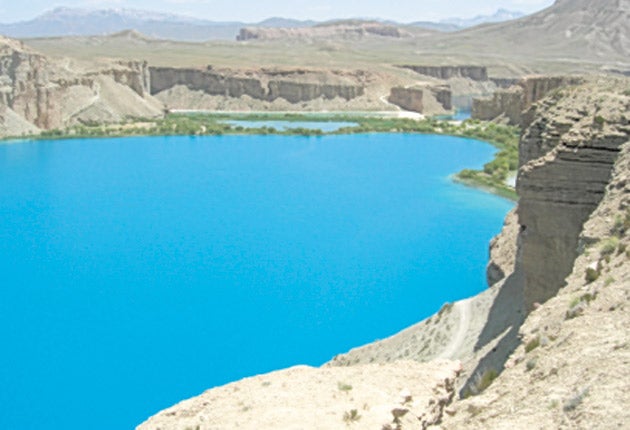Will the opening of a stunning national park attract foreign tourists to Kabul?
Sue Corfield reports on its rocky progress

Better known as a war zone than an area of natural beauty, Afghanistan might not be the first place tourists consider when going to see some of the planet's most stunning scenery.
But in 2009, ambitious plans were announced to establish the country's first national park in Band-e-Amir, near the Bamyan Valley, to the west of the capital Kabul. The area is renowned for its spectacular series of six deep-blue lakes, separated by natural dams made of travertine – a form of limestone deposited by mineral springs found in only a few places around the world. Rugged mountains and towering cliffs surround the lakes at the heart of the park, which is considered eligible as a Unesco World Heritage Site.
The park must wait three years before it can gain official status, but in the meantime, the Wildlife Conservation Society (WCS), with funding from the United States Agency for International Development (USAID), is driving the park's creation. WCS is now working with field scientists and local communities to develop the park's management plan, train local rangers and win hearts and minds.
The effect of the conflict, both directly through bombings and indirectly through displaced people forced to find shelter, fuel and food, has resulted in degradation of the Afghan environment, over-hunting and depletion of indigenous species. The area is already benefiting from a ban on hunting and fishing. Previously, netting and explosive fishing techniques had devastated the fish and waterfowl populations. The WCS's goal is to encourage eco-tourism to help to create supplemental income for villagers to assist in the preservation of the park's depleted wildlife.
The nature of the war results in travel and communication difficulties for the conservationists working out in the field. Military helicopters provide the main form of transport, and extreme weather conditions combined with a remote location provide the main challenge for conservationists living in the park villages.
Additional funds have been secured from the Afghan government to establish a park office, an entrance complex and a ranger station. There is also money for ranger recruitment and training, hiking trails, campsites and to make road improvements. David Bradfield, a WCS field officer, said: "Setting up a national park is complex matter and involves many elements, including... most importantly, establishing local support. There are around 14 small villages within the national park, comprising mainly the Hazara tribe, a more peaceful folk who are fortunately anti-Taliban, hence we are able to work and live here.
"We integrate as much as we can in village life, building relationships slowly but surely," he added. "We have taken up playing football with the local youth in the evenings. In general, wildlife is on borrowed time, due to hunting pressure and habitat loss. As a result, it is vital to get the local villagers to buy into the promise of eco-tourism to help protect the area."
Mr Bradfield believes visitor figures are on the up, with an average of 2,000 people visiting on summer weekends. He concluded: "Bamyan's classification as a 'safe' province means visitors are already on the increase and possible revenue-generation opportunities – from jobs to accommodation and park-entrance fees – are becoming more feasible."
Though much of the park's wildlife has been lost, recent surveys indicate the area still contains ibex, urial, wolves, foxes and Afghan snow finches. Common Persian leopards are rumoured to be in the remote mountains and this could be confirmed later in the year when the results of a camera-trapping survey are concluded.
Band-e-Amir is still visited by Afghan pilgrims but foreign tourists are a rare sight. It is hoped that the area will once again attract international visitors in a more peaceful future.
Subscribe to Independent Premium to bookmark this article
Want to bookmark your favourite articles and stories to read or reference later? Start your Independent Premium subscription today.

Join our commenting forum
Join thought-provoking conversations, follow other Independent readers and see their replies